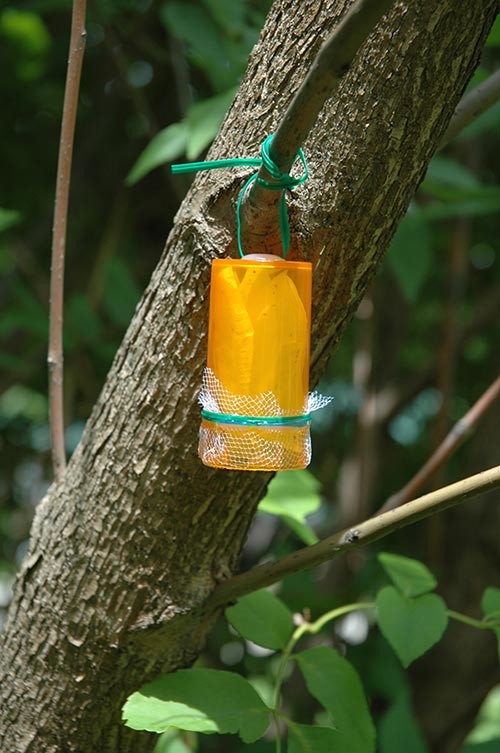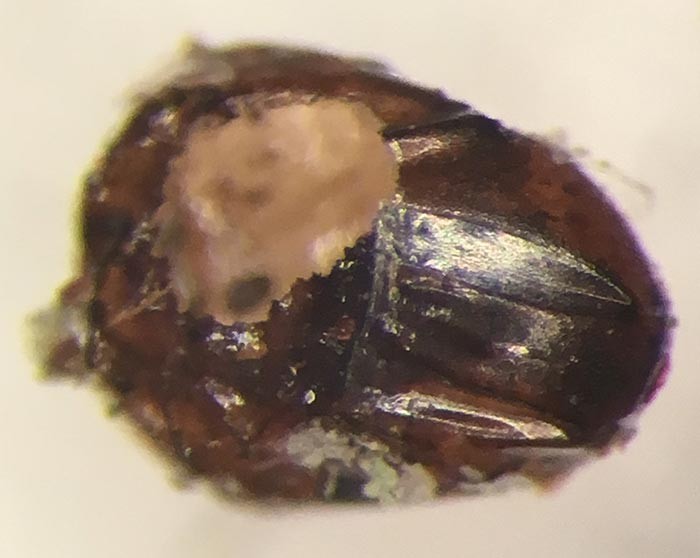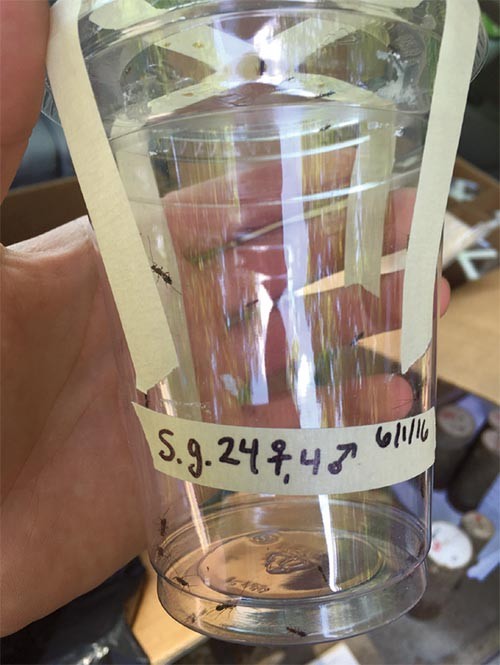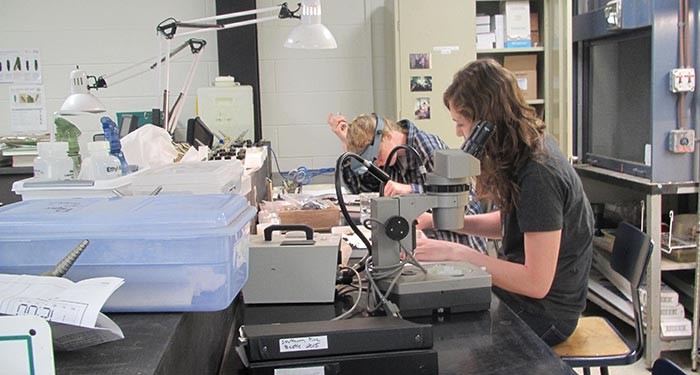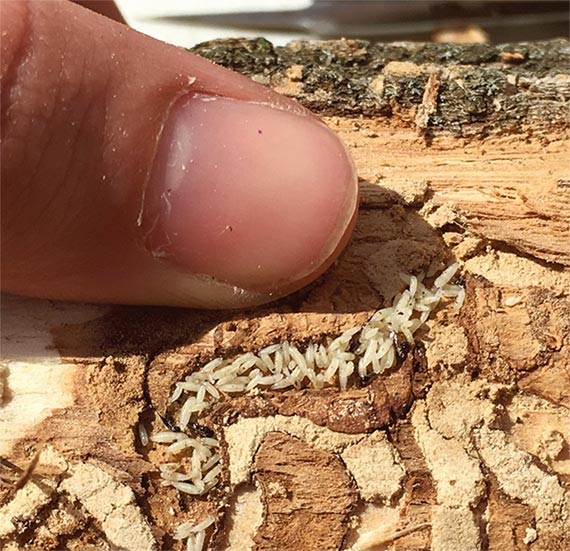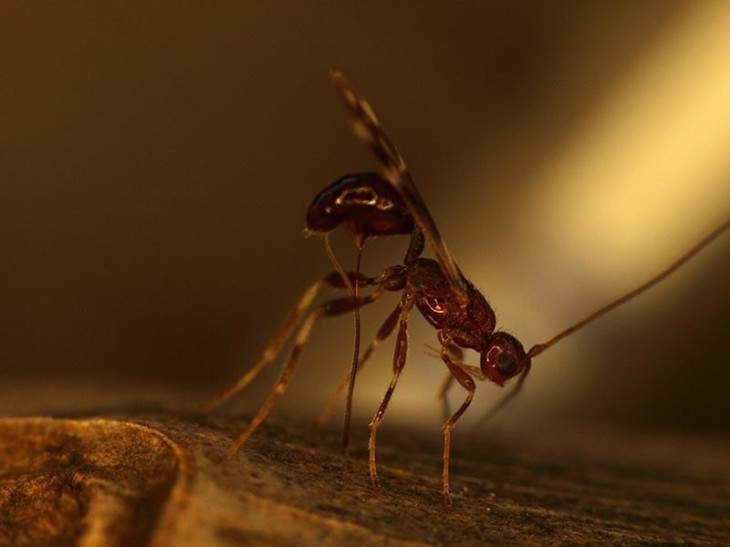
The mixed hardwood forest on the edge of the town of Dalton in western Massachusetts looks healthy to the untrained eye, but the researchers from the University of Massachusetts who visited the site every few weeks last summer are anything but untrained. They quickly noted the small holes made in some trunks by foraging woodpeckers and distinguished them from the even smaller holes made by wood-boring beetles. And staring into the canopy, they observed that many of the trees were in the early stages of decline.
The forest, which consists primarily of white ash and red maple, is owned by the nearby city of Pittsfield to protect its public drinking-water supply. But now it also serves as a living laboratory to test a variety of methods for controlling the emerald ash borer, an iridescent green beetle native to China that has killed hundreds of millions of ash trees in the eastern and central United States and in Ontario and Quebec.
The invasive beetle was discovered near Detroit in 2002 and has relentlessly spread in all directions, reaching New York in 2008, Massachusetts in 2012, and New Hampshire in 2013. It’s only a matter of time before it reaches the forests of Vermont and Maine. Unchecked, the beetles are expected to kill almost all of the mature ash trees in the region in the next decade or two.
So researchers are looking for methods to control the invasive beetle and to protect future generations of ash trees. In the Dalton forest, select trees have been injected with a systemic pesticide to test whether adjacent trees also benefit from the treatment, but such methods would be hard to replicate on a landscape scale. In light of this, the forest is primarily home to a series of biological control experiments to determine whether the emerald ash borer’s natural enemies in Asia might succeed at keeping the insect in check here as well.
At one of these experiment sites, research fellow Ryan Crandall wandered the forest carrying two medicine bottles capped with a fine mesh. Inside the bottles were coffee filters embedded with emerald ash borer eggs, and inside the eggs were the larvae of Oobius agrili, a tiny parasitic wasp that is one of several insects that scientists hope will do in the US what they do in China – control emerald ash borer populations so native ash trees can continue to thrive.
Crandall and his assistant, Sebastian Harris, were seeking the perfect trees on which to hang the prescription medicine bottles – trees that weren’t too far gone yet but that have lots of woodpecker holes, a tell-tale sign of emerald ash presence. Most of the larger trees they examined were near death, but eventually the researchers selected a couple of smaller specimens and proceeded to hammer nails into their trunks and hang the pill bottles on the nails. Soon, they hoped, the parasitic wasps would emerge and seek out more emerald ash borer eggs in which to lay their own eggs.
Although Crandall and Harris spent just 30 minutes at the Dalton site, they were far from finished for the day. They had five more stops to make at similarly infested forests in Massachusetts, New York, and Connecticut, where they left behind a total of 1,400 eggs.
Off Target
Thanks to global travel and trade, the invasion of non-native insects and plants has been an ecological and economic problem for more than a century in the US. Ridding an area of an exotic invader using chemical pesticides and mechanical means is a costly and labor-intensive exercise that seldom works. And while the use of biological control agents won’t completely eradicate the pest either, advocates say an ecological fix and a self-sustaining strategy is preferable from an ecological perspective and may reduce the damage caused by invasive insects and plants over many years.
UMass entomologist Joe Elkinton described what he called classical biological control as an effort to “reunite pest species with the natural enemies that typically keep them from being a problem in their country of origin.”
His colleague Roy Van Driesche added, “Every other strategy is temporary and local and costs a lot of money. If the problem is something causing difficulty over the whole landscape, and you need relief at the landscape level, [as with the] emerald ash borer, then you can’t do it with any other tool except an organism that will spread, reproduce, and show up year after year on its own.”
Biological control has been used to control crop pests in Asia for more than a thousand years, beginning when Chinese citrus growers placed nests of predaceous ants in their trees so the ants would feed on foliage-eating insects. It got its start in the United States in the 1880s under the direction of the Department of Agriculture. The agency had its first success before the turn of the twentieth century, when an Australian ladybug was released in California to control the cottony cushion scale, an invasive insect that was wreaking havoc on the state’s emerging citrus-farming industry. It cost just $1,500 to control the scale insect and eliminate the problem. Since then, hundreds of insects have been identified as possible agents for controlling a wide variety of exotic species, from aquatic weeds to forest pests.
When the emerald ash borer first became a problem in Michigan, and cutting down and grinding up the infested trees didn’t solve it, entomologist Juli Gould from the Cape Cod office of the USDA’s Animal and Plant Health Inspection Service (APHIS) went to China to learn about the borer’s natural enemies, most notably a variety of parasitoids – what Van Driesche described as “wasps that don’t sting and are about as big as a yellow jacket’s toenail” – that lay their eggs in or on emerald ash borer eggs or larvae. The wasp larvae flourish and the borers die.
Before the parasitoids could be released in the US, however, a lengthy series of “host specificity tests” were conducted to ensure that the parasitoids weren’t going to kill non-target native insects as well. That was the problem that surfaced in the early days of biocontrol efforts, when little attention was paid to the effect of the biocontrol agent on living organisms beyond the target pest.
In the early 1900s, for instance, a wide variety of non- native parasitic insects were released to control gypsy moth caterpillars. None worked effectively on that target pest, but one of those released insects, a tachinid fly, was later found to kill the caterpillars of many other moths and butterflies, including popular and beneficial species. So years of testing are now conducted in research laboratories to ensure that the biocontrol agents only prey upon the targeted invasive species. If the targeted pest is an insect, like the emerald ash borer, then numerous closely related native insects are tested to make sure the agent doesn’t also attack the relatives. If the target is an invasive plant, then as many as 100 related plants are tested. Several government agencies must sign off before the insects are released into the environment.
Oobius agrili and three other emerald ash borer enemies (Spathius agrili, Spathius galinae, and Tetrastichus planipennisi) were tested at an APHIS facility in Michigan, near where the infestation began. But two labs in New England also conduct these types of host specificity tests for a number of other bio-control agents.
Biocontrol Agents
Security is high at the quarantine facility at the University of Rhode Island’s Biological Control Laboratory in Kingston. Rather than keeping people out, the security is designed to ensure that the insects stay in. Researcher Lisa Tewksbury entered a security code to open the first door to the facility, which led into a small, dark entryway she calls “the room of last resort,” illuminated only by an overhead bug zapper she hopes will attract and kill any insect attempting to escape. Once the first door closed, she opened a second door into a prep room, where she donned a white lab coat. It’s in this room where any soil or plant material destined to be discarded is first cooked in an autoclave or frozen for several days so surviving insects don’t accidentally make it out alive.
Beyond the prep room, students in three brightly lit labs provided food to various insects and experimented with methods of raising them. In one, Hypena moth caterpillars, which were found to eat only black swallowwort – an aggressive invasive vine that may be harmful to monarch butterflies – chewed on swallowwort leaves in Plexiglas cages while they awaited government approval to be released. Another room contained bins filled with stalks of Phragmites, an invasive reed that out-competes native wetland plants. The Phragmites was being fed upon by the caterpillar of a European moth that kills the plant by burrowing into its stem and eating it from the inside out.
In an adjacent room containing chambers filled with lily plants, invasive lily leaf beetles were being reared for further testing. The blood-red beetle, which has wiped out populations of native and ornamental lilies throughout the Northeast, has been successfully controlled in Rhode Island and eastern Massachusetts by a parasitic wasp raised at the URI facility. The wasps have been shipped to partner researchers in Maine, New Hampshire, Connecticut, and Ontario for release in affected areas, and Vermont scientists recently requested their first batch of the wasps as well.
Richard Casagrande, the professor who leads the biocontrol research program at URI, said insects identified as potential biocontrol agents against invasive plants are tested under “no choice” conditions, meaning that the insect is provided with only one type of plant to eat at a time. “If they can live on it, they will; if they can’t, they die,” he said.
It usually takes years of host specificity testing and about $1 million in research funding before Casagrande is confident that an insect is safe to release. He said it took more than five years of testing of the control agent for lily leaf beetle, and even longer for the Hypena moth that eats swallowwort. When testing is complete, he petitions APHIS for a release permit.
A New Era?
Not everyone thinks biological control is the answer to the invasive-species problem. Dan Simberloff, a professor at the University of Tennessee, urges caution. He isn’t opposed to biocontrol on principle, but he doesn’t think it should be the first strategy employed to fight pests. “It’s often irrevocable if the species you introduce survives and doesn’t do the job,” he said. “There’s a good chance it may have impacts on non-target species.”
Simberloff said there have been highly successful biocontrol projects for aquatic plants and crop pests, “but there is no history of a successful biological control project for a significant forest pest. I’m not saying it won’t work now, but it hasn’t worked yet. Never once.”
He notes that five beetles, two flies, and a fungus have been released since 1995 to fight the hemlock woolly adelgid, an aphid-like insect that is killing hemlock throughout its range. And while most of the control agents have survived, none have slowed the death of the trees or slowed the spread of the adelgid. Simberloff is especially concerned about the parasitoids being released to control the emerald ash borer. He said there are about 100 native jewel beetles in the same genus as the ash borer that could be at risk.
“They have tested these three biocontrol wasps on very few of them,” Simberloff said. “Some of these jewel beetles are seen only once every few years or every decade, so if they disappear, we’ll never even know.”
He admitted that he knew of no alternative to biocontrol to fight the emerald ash borer, but he thinks scientists are working too quickly and not being careful enough in testing biocontrol agents – particularly for the hemlock woolly adelgid.
Joe Elkinton agreed that biocontrol is not always successful, noting that each case is unique, and sometimes no natural enemies exist to stabilize some pests. He has worked for nearly three decades on biocontrol of the hemlock woolly adelgid, and while he acknowledged that the project was “limping along” – especially in the Northeast, where the most promising control agents do not appear to survive the cold – he believed a breakthrough might be on the horizon with a predatory beetle from the Pacific Northwest that has been introduced in North Carolina.
“We don’t have the answer yet, but there are various other natural enemies being evaluated,” Elkinton said. “It may take a suite of these things to control the adelgid.”
Most public opposition to biological control emerges from periodic news reports about biocontrol horror stories from a century ago, like the early gypsy moth efforts or the release of mongooses in Hawaii and cane toads in Australia. Biocontrol practitioners say there are plenty of bad examples, but most of those species were introduced by non-scientists with no oversight at a time when the only insects most people cared about were honey bees.
“I don’t want to have to defend actions from a century ago,” said Casagrande. “You don’t think we’ve learned anything since then? Doctors were practicing bloodletting back then, but nobody avoids going to the doctor these days because of it.”
Van Driesche makes a similar argument. “You wouldn’t judge your risk of having open heart surgery by outcomes in the 1950s, would you?”
They noted that the national and international standards now in place and required host specificity testing and government approval for every insect release have slowed the number of biocontrol agents that have been released in recent decades. Since the new rules were implemented, two recent studies of the safety of biological control concluded that more than 99 percent of releases have had no significant effect on non-target species.
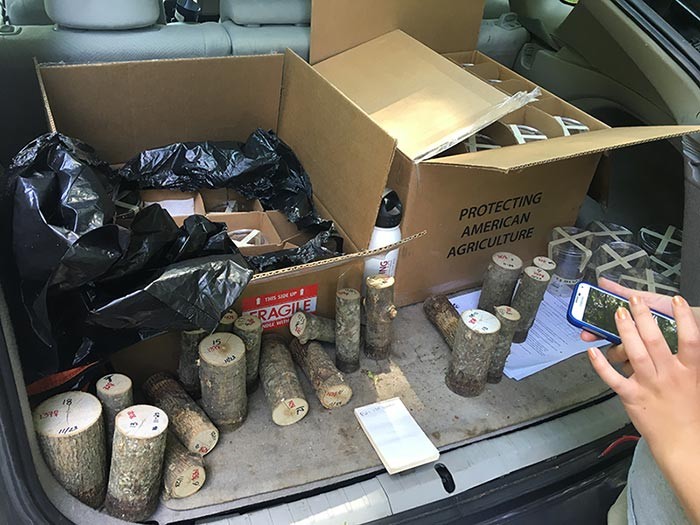
Biocontrol Cost-Benefit
What’s likely to be the next pest that biocontrol researchers will delve into? The Asian longhorn beetle is an excellent candidate. It meets at least two of what Casagrande said are the primary requirements: It’s a serious problem, and it is not easily controlled in any other way. The third requirement – that it be controllable by a host-specific agent – is uncertain at this time.
Elkinton traveled to Korea in 2015 in search of the beetle’s natural enemy but came home empty-handed. Gould went searching in China and found a parasitic beetle that showed promise, but host specificity testing is just beginning.
“We have to create an environment in the lab where beetles will feed in wood,” she said. “We have to collect the adults, get them to lay eggs, rear the larvae on an artificial diet, and put the larvae in logs. It’s not going to be easy.”
Gould is excited about the prospects of using biocontrol on a new invader from China, the spotted lanternfly. It has been found only in six counties in Pennsylvania so far, but Gould expects it to spread widely. She is already studying an egg parasitoid in quarantine, but the lanternfly lays its eggs in the fall and the parasitoid is only active in spring, so it isn’t promising. Collaborators in China have identified another possibility, which she hopes to begin testing soon.
“We think the spotted lanternfly has to feed on tree-of-heaven in its last nymphal stages and first adult stages,” Gould explained. “Tree-of-heaven is an invasive and exotic plant, so if the lanternfly only ate tree-of-heaven, that would be awesome, because we’d love to kill [that tree]. But it doesn’t. It’s also a pest on grapes and fruit trees.”
According to the researchers, one of the biggest challenges to fighting invasive insects is that by the time land managers or entomologists discover a new invader, it’s usually too late to eradicate it using conventional means. This often leaves biocontrol as the best option.
To Joe Elkinton, who said his most successful biocontrol effort was the use of a parasitic fly to control invasive winter moth populations in Maine, Massachusetts, and Rhode Island, the bottom line is balancing costs and benefits even when the control agent isn’t entirely host specific.
“We have to ask ourselves, ‘do we care more about the close relatives of the pest and that their populations will be reduced, or do we care more about losing our ash and hemlock trees?’” he said. “Because when we lose those trees, all the insects that feed exclusively on those trees are also going to die, and that has eco-system-level implications. So we need a rational discussion as we anticipate the future of biocontrol. We need to weigh the cost of doing nothing with the cost of introducing a biocontrol agent.”
As he told Slate magazine for an article on this subject, “In the absence of biocontrol, there is no solution.”


